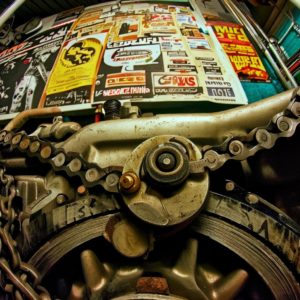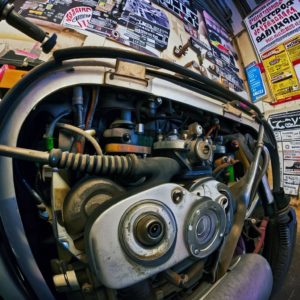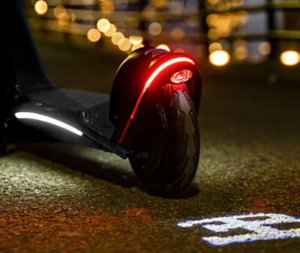How do Gas-Powered Scooters Work?
How do Gas-Powered Scooters Work?

AI Art Impression
Introduction to how gas-powered scooters work: Gas-powered scooters are compact two-wheelers that run on internal combustion engines. They are a popular mode of transportation due to their fuel efficiency and convenience, making them an excellent choice for short-distance travel in urban areas.
The importance of understanding scooter mechanics: Understanding scooter mechanics is crucial for scooter owners because it empowers them to perform basic maintenance, diagnose issues, and make informed choices about modifications or upgrades. This knowledge can save money on repairs and ensure a safer and more enjoyable riding experience.
The basic working principle of gas-powered scooters: Gas-powered scooters operate on the principle of internal combustion, where fuel and air mix in the engine’s cylinder. This mixture ignites, creating controlled explosions that power the scooter’s movement. The resulting mechanical energy is transmitted to the wheels, propelling the scooter forward.
How do Gas-Powered Scooters Work? – Internal Combustion Engine
Explanation of the internal combustion engine in gas-powered scooters: The internal combustion engine in gas-powered scooters is a key component responsible for generating power. It works by mixing fuel and air in a combustion chamber, igniting the mixture, and converting the resulting energy into mechanical motion, which drives the scooter’s wheels.
The components of the engine: Gas-powered scooter engines consist of various components, including the cylinder, piston, crankshaft, and valves. The cylinder houses the piston, which moves up and down, driving the crankshaft’s rotation. Valves regulate the intake of air and expulsion of exhaust gases, ensuring efficient engine operation.
The four-stroke vs. two-stroke engine debate: The debate between four-stroke and two-stroke engines in gas-powered scooters revolves around their respective designs and performance characteristics. Four-stroke engines are known for their fuel efficiency and reduced emissions but tend to be heavier. Two-stroke engines, on the other hand, are lighter and simpler but may produce more emissions. The choice between these engine types depends on factors like fuel economy, emissions regulations, and rider preferences.
Fuel System

AI Art
How the fuel system functions in a gas-powered scooter: The fuel system in a gas-powered scooter is responsible for delivering the right amount of fuel to the engine. It typically includes components like the fuel tank, fuel pump, carburetor or fuel injector, and fuel lines. When you start the scooter, fuel is drawn from the tank and mixed with air in the carburetor (or injected directly in fuel-injected models). The air-fuel mixture is then ignited in the engine to generate power.
Types of fuel used in gas-powered scooters: Gas-powered scooters primarily use gasoline as fuel, with various octane ratings available. Some scooters may also run on ethanol-blended fuels. It’s essential to consult your scooter’s manual to determine the recommended fuel type and octane rating for optimal performance.
Fuel efficiency and mileage: Gas-powered scooters are known for their excellent fuel efficiency, often providing impressive mileage per gallon. Factors affecting fuel efficiency include engine type (two-stroke vs. four-stroke), engine size, riding conditions, and maintenance. Regular maintenance and careful riding can help maximize fuel efficiency and extend the distance you can travel on a tank of fuel.
How do Gas-Powered Scooters Work? – Ignition System

AI Art
Overview of the ignition system: The ignition system in gas-powered scooters is responsible for igniting the air-fuel mixture within the engine’s cylinder. It typically includes components like spark plugs, ignition coils, and timing systems. When the spark plug generates a spark at the right moment, it ignites the compressed air-fuel mixture, initiating the power stroke in the engine.
Different ignition methods (CDI, points ignition, etc.): Gas-powered scooters employ various ignition methods, with two common types being CDI (Capacitor Discharge Ignition) and points ignition. CDI systems are electronically controlled and offer precise timing, while points ignition relies on mechanical points and may require more maintenance. Choosing the right ignition method depends on the scooter’s design and performance requirements.
Importance of proper ignition timing: Proper ignition timing is crucial for efficient engine operation. If the timing is off, it can lead to reduced power, poor fuel efficiency, and increased emissions. Regularly checking and adjusting the ignition timing is essential for maintaining optimal scooter performance.
Transmission System

AI Art
How the transmission system works: The transmission system in gas-powered scooters is responsible for transferring power from the engine to the wheels. It consists of various gears that allow riders to change the scooter’s speed. By shifting gears, riders can match engine power with different riding conditions, such as starting from a stop or cruising at high speeds.
Variations in transmission (automatic vs. manual): Gas-powered scooters come with either automatic or manual transmissions. Automatic scooters use a continuously variable transmission (CVT) that adjusts the gear ratio automatically, providing a smooth and hassle-free riding experience. Manual scooters, on the other hand, require riders to manually change gears, offering more control over acceleration and speed but demanding more skill.
Drive belts, chains, and gears: Gas-powered scooters can employ different methods for transmitting power from the engine to the rear wheel. Some use drive belts, which are quiet and low-maintenance. Others use chains, which are more durable but may require periodic lubrication and adjustment. Gears within the transmission system dictate the ratio between engine speed and wheel speed, allowing riders to accelerate and maintain desired speeds efficiently.
Carburetion and Air-Fuel Mixture

AI Art
Role of the carburetor: The carburetor in gas-powered scooters is responsible for mixing the right proportion of air and fuel before it enters the engine’s combustion chamber. It plays a crucial role in regulating the engine’s performance and fuel efficiency by ensuring the correct air-fuel mixture.
Adjusting the air-fuel mixture for optimal performance: Achieving optimal performance involves adjusting the air-fuel mixture to the scooter’s specifications. This adjustment is typically done by tuning the carburetor to balance power and fuel efficiency. Fine-tuning the carburetor can enhance acceleration, fuel economy, and overall scooter performance.
Troubleshooting carburetor issues: Carburetor problems can lead to poor scooter performance. Common issues include clogs, dirty components, or misadjustments. Troubleshooting involves inspecting and cleaning the carburetor, checking fuel lines and filters, and ensuring proper adjustments to maintain the correct air-fuel ratio.
How do Gas-Powered Scooters Work? – Exhaust System

AI Art
The purpose of the exhaust system: The exhaust system in gas-powered scooters serves two primary purposes. Firstly, it directs and channels the exhaust gases away from the engine, preventing harmful fumes from entering the rider’s space. Secondly, it utilizes a muffler to reduce noise emissions, making the scooter quieter and more environmentally friendly.
Types of exhaust systems (stock vs. aftermarket): Gas-powered scooters often come with stock exhaust systems, which are designed for basic functionality and noise reduction. Aftermarket exhaust systems, on the other hand, offer customization options for improved performance, sound, and aesthetics. Riders can choose between stock systems for compliance with regulations or aftermarket systems to enhance their scooter’s characteristics.
Emissions and environmental considerations: Emissions from gas-powered scooters, including carbon monoxide and hydrocarbons, contribute to air pollution. Environmental considerations are crucial, and many regions have emissions regulations in place to limit scooter emissions. Choosing eco-friendly practices like proper maintenance and using catalytic converters or cleaner-burning fuels can help reduce the environmental impact of gas-powered scooters.
Electrical System

AI Art
The electrical components in gas-powered scooters: Gas-powered scooters incorporate various electrical components to facilitate essential functions. These may include a battery for starting, lighting systems (headlights, taillights, turn signals), ignition systems, and wiring to connect these components to the scooter’s electrical system.
Battery, lights, and wiring: The battery in a gas-powered scooter provides the electrical energy necessary for starting the engine and powering the lights and other electrical accessories. Lights are essential for visibility and safety, including headlights for night riding and turn signals for signaling intentions. Wiring connects all these electrical components, ensuring they function properly.
Maintenance tips for the electrical system: To maintain the electrical system in gas-powered scooters, periodically inspect and clean battery terminals to prevent corrosion, ensure proper charging, and extend battery life. Check and replace any burnt-out bulbs or damaged wiring to maintain lighting functionality. Additionally, keep an eye on the condition of the electrical connections and wiring harnesses, and address any issues promptly to avoid electrical problems while riding.
.
Maintenance and Troubleshooting
Routine maintenance tasks for gas-powered scooters: Routine maintenance is essential for keeping gas-powered scooters in good condition. Tasks include regular oil changes, air filter replacement, spark plug checks, tire pressure checks, and brake inspections. These tasks ensure optimal performance and safety.
Common problems and their solutions: Common scooter issues may include starting problems, engine stalling, poor fuel efficiency, and unusual noises. Solutions often involve checking fuel and ignition systems, cleaning or replacing air filters, addressing carburetor issues, and maintaining proper tire pressure. Regular maintenance and timely troubleshooting can prevent and resolve many common problems.
Tips for extending the lifespan of your scooter: To prolong your scooter’s lifespan, follow the manufacturer’s maintenance schedule, use high-quality fuel and oil, and keep the scooter clean. Store it in a dry and sheltered place to prevent rust and protect it from the elements. Additionally, avoid aggressive riding habits and follow safe riding practices to reduce wear and tear on critical components.
Future Trends in Gas-Powered Scooters

AI Art
Emerging technologies in the scooter industry: The scooter industry is seeing advancements in engine efficiency and emissions reduction technologies, allowing gas-powered scooters to meet stricter environmental standards. Additionally, smart features such as digital displays, connectivity options, and advanced safety systems are becoming more prevalent, enhancing the overall scooter experience.
Eco-friendly alternatives and electric scooters: As environmental concerns grow, there’s a rising interest in eco-friendly alternatives, including electric scooters. Electric scooters produce zero emissions and are gaining popularity in urban areas as a sustainable transportation option. However, gas-powered scooters may still find a niche in markets where longer ranges and higher speeds are required.
The future of gas-powered scooters: The future of gas-powered scooters may involve continued innovation in engine technology to reduce emissions and improve fuel efficiency. They may coexist with electric scooters, serving different market segments based on performance needs and environmental considerations. Ultimately, the future of gas-powered scooters depends on their ability to adapt to changing regulations and consumer preferences while maintaining their appeal as a convenient mode of transportation.
Conclusion
The article “How do Gas-Powered Scooters Work?” provides a comprehensive and insightful overview of the mechanics behind gas-powered scooters. It effectively breaks down complex concepts, making them easily understandable for readers of all levels of familiarity with scooters. The use of clear language and concise explanations is commendable. Additionally, the inclusion of maintenance tips and environmental considerations adds practical value. However, a brief historical context or evolution of gas-powered scooters could enhance the article further. Overall, it’s a well-structured and informative piece that caters to both beginners and scooter enthusiasts.

Before you go Enter the Draw for the Bugatti Electric Scooter Draw Here:
Ebikes Worth Mentioning Click Here
Back to top
To use our purchasing process you must be 18 years of age or older to purchase any product on our website and not represent or purchase on behalf of anyone under this age as set at the point of purchase. The scooter will be registered on our database to the Name and Address etc of the purchaser.
This post or page may contain affiliate links that may earn a small commission at no additional cost to you. I use affiliate links because they allow me to share useful products and services with you that are related to the topic of my website. Affiliate links also help me earn some income from my website, which enables me to keep creating high-quality content for you. I appreciate your support and trust!
- Health Benefits of Electric Bikes
- What to Look for When Buying an E-bike
- Best Electric eBikes for Your Little One
- How to Safely Unlock the Top Speed on Unagi Electric Scooters
- Breaking: The Shocking Truth About E Scooter Laws in WA!
- Can You Ride Scooters On The Road “California”
- Can Electric Scooters Get Wet? Yes!
- How do I transport my electric scooter in a car?
- Top 6 Long Range Electric Scooters
- Two-Stroke or Four-Stroke? Gas Scooter Showdown


